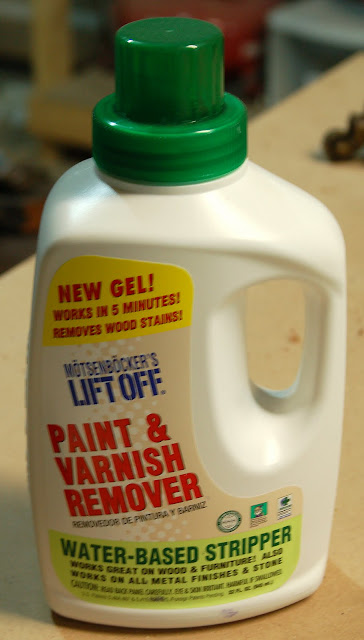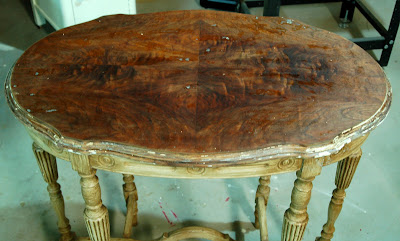As a continuation of the furniture refinishing and painting series, I'm going to cover furniture stripping. Donna is dishing some great photography tips, so make sure you visit her blog after you read this post.
When I did a post on stripping furniture several months ago, I shared my hatred of it. That post certainly did not inspire people to go out and try it on their own. Since then, I've warmed to the process. I learned that my hatred of it stemmed from using the wrong products and working on intricate pieces with a billion coats of paint. Only the bravest and/or stupidest DIYers should tackle those. (I fall in one or both of those categories frequently, but not when it comes to paint removal!)
So, the first rule to DIY furniture stripping is to find a good candidate for the procedure.
The best pieces are:
1.) Solid wood and well built, so they are worth the mess and effort
2.) Pieces with large, flat surfaces
3.) Those that only have a few coats of paint
These rules are a reason I like stripping the tops of pieces only. When you get into the bases, legs, drawers, etc, it can get a little complicated and tedious. I would only strip an entire piece if it was really, really, really worth it. But, that's me. You might be braver and/or stupider than I am.
Stripping furniture is like giving birth. It's messy and not fun when you're going through it, but it's very rewarding when you're done. Ok, it's not really like giving birth. You don't need an epidural and your dresser will let you sleep through the night.
You can purchase this at Wal-Mart for about $9.00 a bottle and it does a fine job.
The other supplies you need for stripping are gloves, a respirator mask, a chip brush (natural bristle brushes that you can purchase for about $.50 apiece), a putty knife, steel wool, a receptacle to put the removed paint in (I like to use a paint tray liner or a cardboard box.) You don't need a respirator if you're working outside, but it's never a bad idea to go overboard on protection where your lungs are concerned.
Apply a liberal layer of the stripping agent on your surface. For a table or dresser top, I like to pour it on and use the brush to move it around evenly. The directions on the bottle say to let it sit for 5 minutes, but I generally let it sit for about 15 minutes. You don't want to leave it on for too long or it will start to dry and it is even harder to remove.
You should start to see your paint or poly bubble and pull away from the surface.
Use a putty knife to gently remove the loose paint and stripper. For the edges or other areas that are curved or difficult to reach with a putty knife, use a steel wool pad.
Continue this process until you've exposed the natural wood.
Once you get a piece to the stage pictured below, apply one more coat of the stripping agent, allow it to sit for a few minutes and then scrub it with a steel wool pad. Wash away any remaining residue with warm water and a rag. Allow the piece to fully dry and then lightly sand before applying paint or stain.
I finish off most pieces with a dark walnut stain and about four coats of Wipe-on Poly in gloss by MinWax. I'll cover this process in the later workshop.
Stripping this freebie, 1980's crackled finished mirror frame transformed it into an updated and expensive-looking piece.
Paint stripper can also be used to create a look of age on a piece. I stripped this headboard of its cream paint, but left some around the edges to simulate paint that has been worn with age.
To recap - For a simple DIY paint stripping experience remember these basic tips:
1.) Stick to pieces that make sense to strip (solid wood, well built, large fat areas, etc.)
2.) Use water based agents
3.) Allow the remover to sit until it's ready
3.) Use steel wool to get into the crannies
Donna, I know you haven't done any furniture stripping in your DIY career, but do you have any questions or other preparation tips to share?
Donna: "I don't really have anything to add in the stripping department yet. :) However, I just wanted to mention, I'm particularly impressed you seem to be doing the opposite of what most would do in the refinishing furniture world, and that's to allow some wood to peek through your painted designs.
You've really put the furniture two-toned effect on the blogmap. I'm not against painting furniture at all, however my point is, watching you refinish furniture through your eyes has really opened up a different catagory for me. Wood and paint marry so well in the right circumstances. The touch of wood also helps anchor a room as well. I now look at every furniture piece as a potential two-toned variation rather than painted out all one colour. There is so much more than can be done than paint something out all in one coat of the same tone!
I also appreciated a previous tip from you on WHY you tend to leave the tops of furniture woodtoned. Durability was one, and now we also know, it's because it's EASIER to do a flat surface. Invaluable information that I'm willing to put to work when I find the right piece. Awesome advice!"
Yes, Donna, a natural wood finish is much more durable that a surface painted in latex. Paint can easily be chipped and scratched. White can especially show wear from keys, change, spills and not every piece looks good with that kind of distress.
Whew! I think we managed to get through a post about stripping without the obvious puns and jokes.
Next week we'll cover more preparation techniques including sanding and deglossing. Make sure you visit Funky Junk Interiors to get some golden information on great picture-taking for your blog.
Donna: "I don't really have anything to add in the stripping department yet. :) However, I just wanted to mention, I'm particularly impressed you seem to be doing the opposite of what most would do in the refinishing furniture world, and that's to allow some wood to peek through your painted designs.
You've really put the furniture two-toned effect on the blogmap. I'm not against painting furniture at all, however my point is, watching you refinish furniture through your eyes has really opened up a different catagory for me. Wood and paint marry so well in the right circumstances. The touch of wood also helps anchor a room as well. I now look at every furniture piece as a potential two-toned variation rather than painted out all one colour. There is so much more than can be done than paint something out all in one coat of the same tone!
I also appreciated a previous tip from you on WHY you tend to leave the tops of furniture woodtoned. Durability was one, and now we also know, it's because it's EASIER to do a flat surface. Invaluable information that I'm willing to put to work when I find the right piece. Awesome advice!"
Yes, Donna, a natural wood finish is much more durable that a surface painted in latex. Paint can easily be chipped and scratched. White can especially show wear from keys, change, spills and not every piece looks good with that kind of distress.
Whew! I think we managed to get through a post about stripping without the obvious puns and jokes.
Next week we'll cover more preparation techniques including sanding and deglossing. Make sure you visit Funky Junk Interiors to get some golden information on great picture-taking for your blog.



















